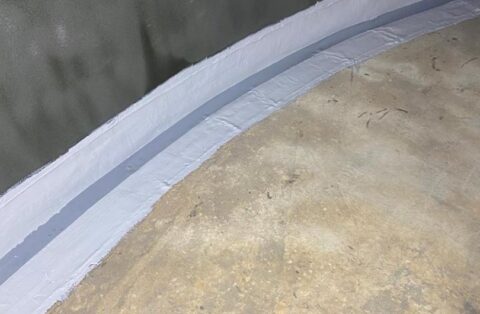Further investigation highlighted deterioration of the joints between the roof panels as the cause for the water ingress. As the GRP roof was beyond its original maximum design life, a complete replacement was required. During the programme Stonbury was further contracted to deliver a refurbishment to the entire tank.
The team erected scaffolding around the structure and cut an access manway into the side of the tank to allow access for scaffolding to support the structure whilst fitting the new roof. The existing roof was replaced with a newly designed GRP roof, expected to last for a minimum of 20 years. A new steel SR4 rated access hatch was then fitted.
An inspection of the internal walls of the tank revealed wide-spread surface corrosion under calcite deposits. Therefore, the client asked the team to remove all the calcite to investigate the full level of corrosion, which the team completed using low pressure water jetting. Once the corroded areas were revealed and reported to the client, Stonbury was asked complete a full refurbishment of the steel wall panels, including overbanding of all joints.
The team prepared the substrate to receive overbanding system and Regulation 31-approved polyurethane coating by grit blasting and crosshatching the steel and concrete surfaces in accordance with ISO 8501-1. A heating system was then installed to ensure the materials were applied and cured as per the Instructions for Use (IFU). Surface temperatures, air temperature, dew point and relative humidity were continuously monitored. Once cured, a spark test was completed to confirm the coating was free from defects.
The team will return to site with the client’s suppliers to install a Watercress security alarm and a cathodic protection system – which is a technique used to control the corrosion of a metal surface by making it the cathode of an electrochemical cell by connecting the metal to be protected to a more easily corroded sacrificial metal. Final works will include installing flap valves to the washout and scour pipes and completing a clean and chlorination before handing the asset back to the client to fill and return to service.











